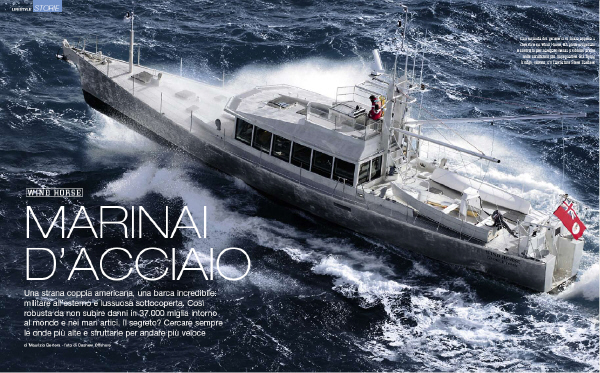For those of you who readItalian, click here for a new review in the magazine Y&S Yacht & Sail.
Archive for 2009
FPB 64 Update 17

The sun is headed south towards New Zealand, and although spring is a little wet right now, soon it will be summer in the Southern Hemisphere. Progress continues on the first four FPB64s, hulls one and two of which are shown above in the fit out bay (one is on the left with its windows in place). From here on out as the interior goes in the photos will show a degree of visual chaos which will continue right up to the day before launching.
Now to some details.
Heat Exchanger Zincs – Critical Maintenance Item

Each heat exchanger aboard has its own sacrificial zinc(s). These need to be replaced periodically, some more often than others. The three above are from the stabilizer hydraulic system heat exchangers. They have seen seven months of service.
There are two larger zincs on each diesel, and two smaller zincs on the transmission oil coolers.
Our habit is to change all zincs at the end of each season, or twice a year if the boat stays in salt water for the winter.
Mainsail Control
Steve,
What do you think of the idea of putting the main boom vang on a circular track so the boom angle and boom height (sail twist) can be controlled. I guess this is the sort of system you would have had in your cats many years ago.
I guess it would alssuito roachy mainsails.
Do you think it could be an effective and efficient means of mainsail control for a large yacht with a shorthanded crew?
Putting Wind Horse To Bed – Winter Storage Items
We have put Wind Horse into sleep mode for the winter. Following are a list of items to which we attended. This looks long, but takes us about two days, plus a day of work by one of the mechanics at Berthon’s. Most of this is preventive in nature, so when we launch in the spring we are ready to go as soon as we do a quick systems check.
Why You Should Periodically Check Your Heat Exchangers

We have just gotten around to removing the end caps on our engine heat exchangers. The first time since launching. As you can see, this was somewhat overdue!
Multiple Monitor System On Wind Horse

When we launched Wind Horse we a single 19″ monitor for the radar. Then we switched to 17″ and added a second monitor for sonar. Finally we added a third so the PC based charting system was aligned with the sonar and radar.
We have lived lived with the temporary installation for two years, and now we have a permanent solution.
Efficient Electric Cooking Part 2 – Convection Apple Pie

Our research into efficient electric cooking continues. This time with an apple pie in the combination microwave/convection oven onboard Wind Horse. The results are encouraging.
Bottom Paint Going Strong After 18,000 Nautical Miles
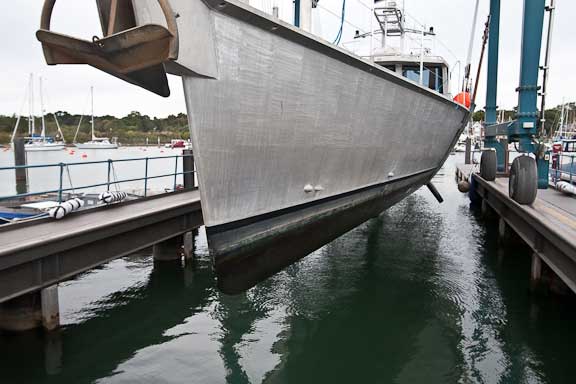
Wind Horse is hauled out and we’ve been inspecting the bottom prior to hydro washing. This bottom paint was applied in Ventura, California, in March of 2008. Since then it has seen 18,000 nautical miles slip by.
Zinc Anode Protection On Aluminum Hulls

We’ve just hauled Wind Horse at Berthon’s in Lymington, UK. Time is short, but we will try and share a few photos. This blog is about the sacrificial zinc anode system.
The photo above is one of the two zincs (out of four total) placed amidships. It has now been in the water 3.5 years, for 4400 hours of engine time, and in excess of 45,000 miles of water flow.
Historic Precedent?

Odds are in the marine business that anything that looks new has been done before in some form or other. As partial evidence we offer the following series of photos taken on the Dart River in the UK.
This is the remnants of a World War 11 era Fairmile patrol vessel. These were used for a variety of anti-submarine, coastal patrol, air sea rescue, and clandestine functions. They had to operate in the awful wind and sea states which abound in Europe, so you can assume they were seaworthy.
Life Line Gate Details

Life line gates are not complicated, yet often they are improperly detailed. The key element is to provide lateral support where the lifeline wire attaches. This is done by bringing the angled brace right to the top of the stanchion. Note also the flat plate tangs to which the lifelines attach.
On the other hand,
English Channel Passage – Unfair Wind Gods
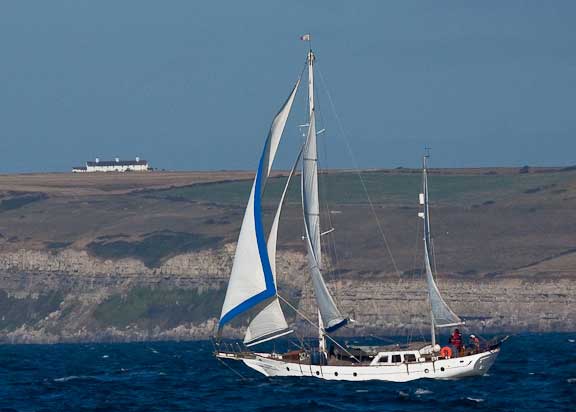
Having spent a lot of miles between the Shetland Islands and Lands End dealing with incessant southwesterlies (on the nose) we were ready for a nice run up the English Channel.
But it was not to be.
Efficient Electric Cooking Part 1
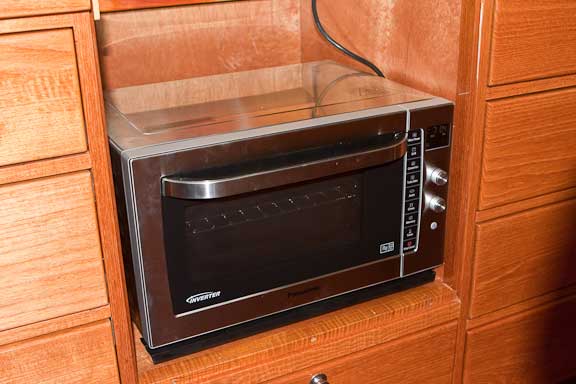
We have just removed our Seaward propane Princess stove and oven. In its place are going a Panasonic WNCF778S combination broiler, microwave, and convection oven, and a Miele CS1212 induction cook top (the latter is intended as a replacement for the temporary induction unit in use aboard for the past 18 months.
Dartmouth, UK – A Great Place to Hang Out
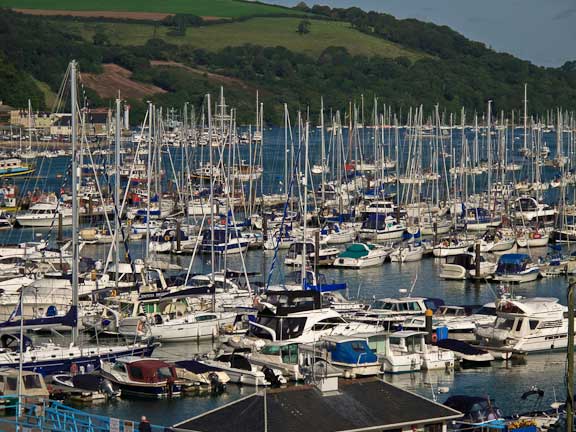
We’ve been hanging out so long now in Dartmouth that our transom is starting to show a small garden. But it is hard to leave. There is a long river to explore with several charming villages, lots to see in town, good restaurants, and for all the tourists about, Dartmouth and its environs have a pleasant ambiance.
The docks and moorings are extremely crowded, but not by the standards of the Solent a little further up the coast. And there is room to anchor. If you look hard you can see Wind Horse in the background just to the right of center.
Spectacular Humpback Whale Photos
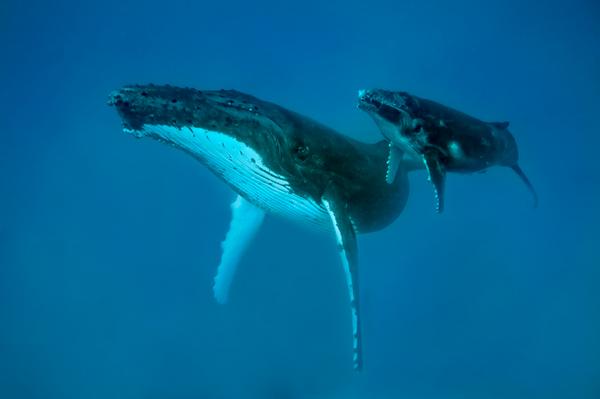
Every once in a while years of preparation and talent coincide with being in the right place at the right time and you get “lucky”. Such was the case a few days ago when Carol and Mike Parker were cruising in Tonga, and happened to be out on a whale watching boat. Carol is a gifted photographer with a feel for the medium second to none. Getting good photos underwater is unbelievably difficult, and submerged whale photos with detail almost impossible. This collection will make your day. To see Carol’s work check out her blog.
Genset or Alternators Underway?
Steve,
I had a question about the cruising alternators on the main engine. I have been reading Ken Williams’ blog and there was a significant amount of traffic on this subject. Bottom lime was concluding that they drew more power, hence fuel, then simply running there normal 20kw generator. They went on to suggest that Nordhavn as a company was no longer installing them on their boats. I know you area a big fan and I was wondering if you could shed some light on the subject
thanks
Scott
Dart River, UK
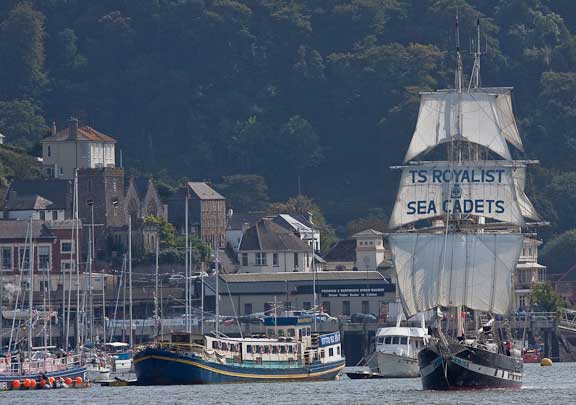
This is one of the compensations for cruising these waters. You see all sorts of wonderful old time vessels (and not a few good looking reproductions). As you may infer from the headline, we’ve been boat watching on the Dart River, a practice in place here for at least a couple of thousand years.
Bare Aluminum Topside Maintenance
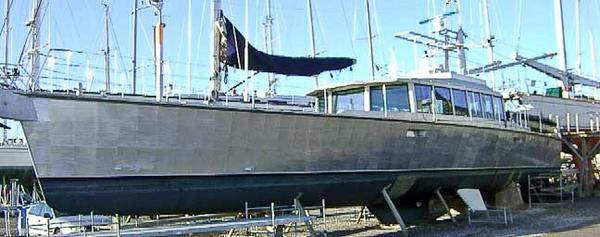
We have discussed in the past the advantages of bare aluminum topsides (no maintenance or worry, initial cost reduction, lower visual profile, etc.). And we have grown to love this look.
But, after three-plus years of cruising, mostly off the beaten path, rafting with commercial vessels and laying on rough docks, we were getting a little tired of the view from the dinghy.
Speed Length Ratio
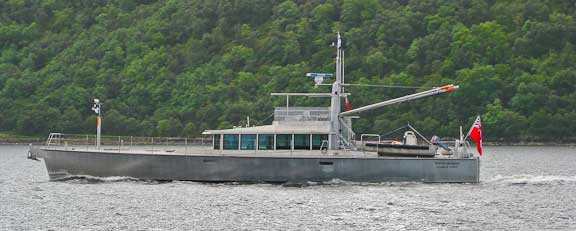
Over the past year we have posted photos of various craft and their bow and stern waves as an indicator of efficiency. This is judged in terms of Speed Length Ratio (SLR) or the boat speed divided by the square root of the waterline length. In the photo above, sent to us by a cruiser in Scotland, Wind Horse is doing her normal eleven knots. She has an 81 foot waterline, the square root of which is nine. Dividing eleven knots by nine gives us an SLR of 1.22.
Multi-headsail Sloop/Cutter
Steve,
Would you comment on the efficacy of the rig described below.
Let’s say we are talking about a 70 – 75 ft sloop/cutter with a DLR of around 60 – 70 – and beam to LOA of around 22% (typical of your style of hull).
It has a large foretriangle and fully battened deep roach mainsail.
The rig probably needs to be only low aspect given the area in the roachy mainsail and with say a 130% overlapping genoa in a large foretriangle.
There are 3 roller furling headsails (130% genoa, 90% jib, 60% jib) for the various wind ranges and an inner, probably permanently rigged, luff wire for a hanked on storm jib.
There are no backstays or runners and the mast has 25deg swept back spreaders.
Do you think this rig could work safely and efficiently?
What would be the main problems of the rig – balancing luff(4)/shroud tensions?
Thanks,
Henry.
New Wind Horse magazine articles
Here are a couple new Wind Horse magazine articles to check out:

Yachting Magazine, July 2009. “London Calling: Seasoned voyagers discover the magic of the historic St. Katherine’s Docks and England’s vibrant capital.”
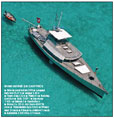
Neptune Yachting Moteur, Summer 2009. This is a review in a French yachting magazine.
Advantages of British Weather
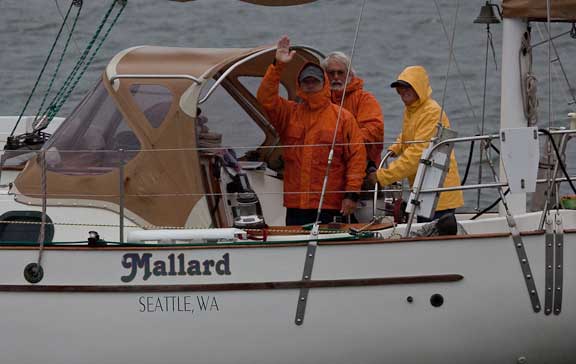
We’ve been thinking about the advantages of British weather. For one thing, folks from the Pacific Northwest of the US feel right at home. Then there is the British penchant for high end foul weather gear which supports a plethora of suppliers and pays for R and D which benefits the rest of us.
History buffs may recall that the island geography and industrial revolution are credited with the push to create the British Empire. But we have a different theory.
FPB Battery Function
Wind Horse and the FPB64 have similar AC and DC systems, so we thought you might be interested in how this is working out in the real world.
The power consumption at anchor on Wind Horse comes primarily from the AC requirements which are satisfied with three 2500 watt Victron inverters. These AC loads are mainly:
Induction Cook Top – Verdict After a Season Of Use
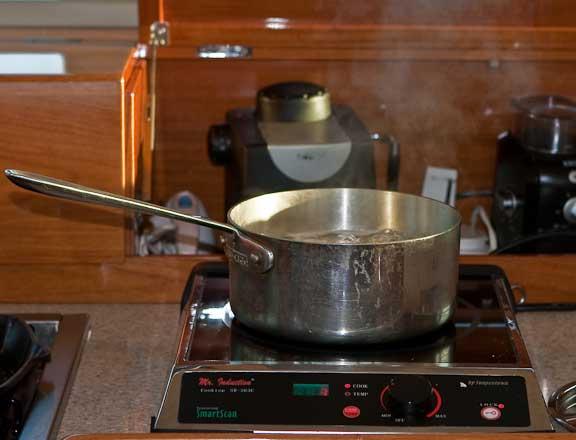
We’ve been using an induction cook top on Wind Horse the past six months in lieu of our propane stove. Between it and the microwave oven, propane consumption has been minimal, the oven being the only consumer now.
So how has this worked out?
Le Grand Bleu – Winner Best Toys Category

Scotland is not the type of place you’d expect to find the mega yacht crowd. But Le Grand Bleu has been hanging around enjoying the Scottish summer with us. From her AIS description she is 107 meters (350 feet) long and 18 meters (60 feet) wide. Enough room for lots of toys.
National Buoy Data Center – Wonderful Source For Real Time Weather
When you’re trying to evaluate weather data – raw models like GFS or faxes from a forecaster – there is always an element of doubt. Just how accurate is the forecast?
An excellent source for real time data is the National Buoy Data Center – http://www.ndbc.noaa.gov/ where you will find not only US data but the rest of the world as well.
Take our recent experience coming down the Irish Sea.
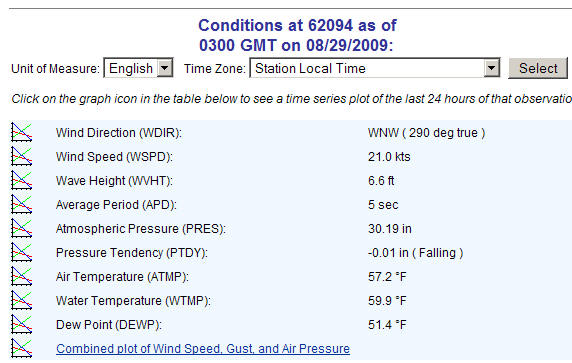
There were two buoys we checked periodically. This one centered between Ireland and Wales in the UK, and another near Lands End at the bottom of the UK. The data above is for the most recent hour. Wind strength, wave height and period, and barometric pressure are of particular interest.
Irish Sea Passage Completed (The Virtue of Patience)
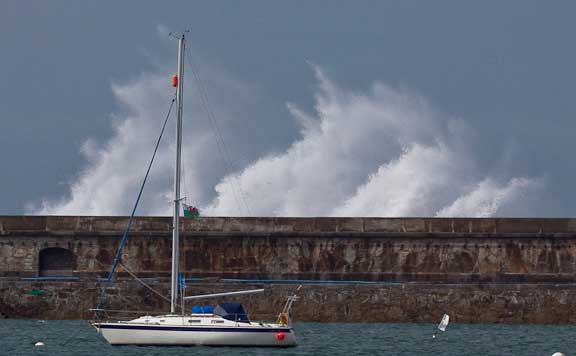
Working your way south down the Irish Sea in late summer is not for the faint of heart nor those with an impatient nature. The winds tend to blow from the south, on the nose, and strong tidal currents guarantee stacked waves for a good chunk of each tidal cycle.
Wind Horse is certainly capable of dealing with these conditions, and making short work of the passage, but her crew has become soft in their dotage. Back in the olden days, say when we used to be sailors, we’d just shorten down and bang our way to windward, and get it over. If the wind was whipping the halyards, and the sea was pounding on the breakwater or barrier reef, we’d say “good sailing breeze.”
We don’t mind open ocean head seas, but when we are seeing twelve to fifteen foot (3.6 to 4.5m) waves with almost vertical faces, these days we prefer to wait.
The periods of relative calm around here are short. On the order of eight to twelve hours is what we have been seeing.
Open 60 World Cruser
Hi Steve and Linda, thanks for all your great work over the years.
I have to qualify this question with a few things. I am young enough (45) to still be crazy, I have extensive (30+years) of offshore (big boat) distance racing experience from the Islands to Nova Scotia, both shorthanded and with full crew, and I am a designer and builder (Houses and Commercial Projects) by trade, who has previously applied skills I have learned to such insane projects as helping to rebuild an Alden 42’ Cutter Rigged Yawl (replacing 77 out of 86 frames…).
I am in the process of considering my next boat. The intended use of this boat will be to do the “reverse” ARC, then bumping around Europe for some time, doing some races as desired, (Fastnet…) ultimately (if the mood strikes) returning after a year or two, or not, as the case may be. In addition while I do like and intend to have creature comforts, I have no problem with an austere (looking) interior (bare carbon or aluminum is fine with me).
Unfortunately one of your boats is not in my budget (although I have coveted one since you started), so I have been looking at used Open 60’s to convert to my idea of “the perfect cruiser”. Fast.
My logic (if you can call it that) is that from what’s available on the market, like the old P&J “Boomerang” while a fantastic boat (I have raced her) for the most part could not be simply modified to my needs (also a bit big, I think 60+/- is my max). My main issue is draft, so I am considering as part of my budget a lifting keel (or even canting/lifting) with a target draft of 4’. What is your opinion of the various lifting keel methods, and their relative strength/safety? Having had a near miss with a partially submerged container on a night with no moon doing 20+ Knots, I have some concerns.
In addition what are your thoughts on “detuning” (reducing the sail area (slightly)) such a boat for the displacement that I would have, since I will not be carrying the sail inventory or supplies for a non-stop around the world trip (I will have a complete inventory, but carrying 9 chutes/code-0’s – 6 Jibs and – 4 Staysails is more than I would use). My goal is to have target speeds of about 20 KTS reaching and 13 KTS Beating in 15 KTS. I would like to eliminate the runners and struts associated with such a large rig.
Thank you in advance.
Craig
FPB 64 Update # 16
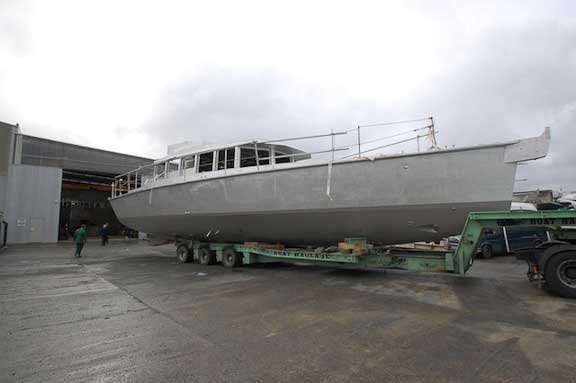
We’ve got lots of photos to share in this update so make yourself comfortable. We’ll start with FPB 64 #2 making a brief journey from the metalwork shop to the fitting out area.
Holyhead, Wales, UK
The weather gods needed a breather and backed off the accelerator for half a day and we’ve scooted south with just fifteen to twenty knots of breeze on the nose. Early afternoon had us off Holyhead Harbor in Wales. Conditions were favorable to continue, but when we looked the Anglesey area up in the guidebook the words “Roman era fort” caught our eye.
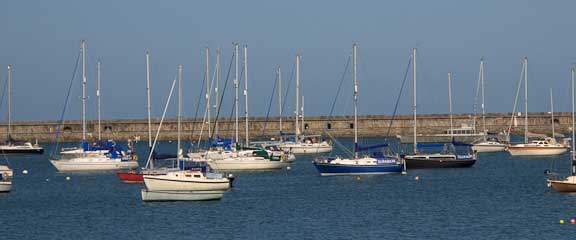
Holyhead is protected by the largest breakwater in Europe, a huge mid-19th century structure, 2.4 km long which took 29 years to construct. There is a crowded mooring field, room to anchor (that’s us in the background) and a nice marina.
And the harbor is busy!
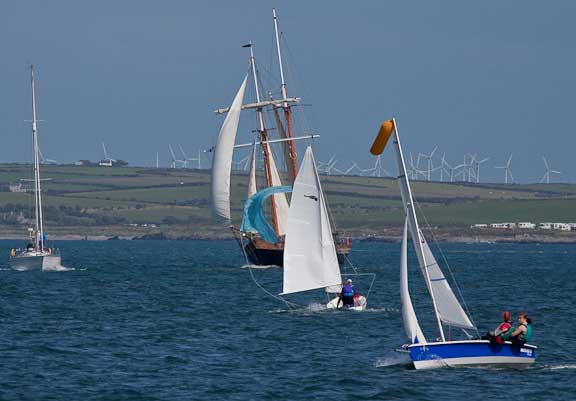
There are two dinghy clubs conducting summer youth training, classic sailing vessels, and yachts coming and going.
Benefits of Scottish Summer Weather
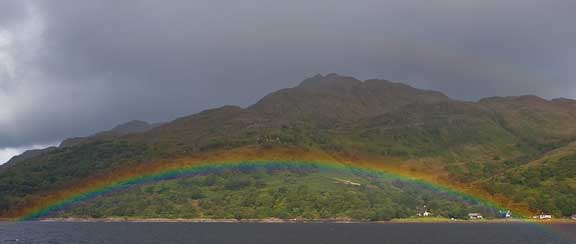
Maybe we’ve been a little hard on the Scots about their weather. Can’t do much about it, so we have learned to ignore the wet and wind and enjoy the brief periods of sunshine.
Heading South From Scotland
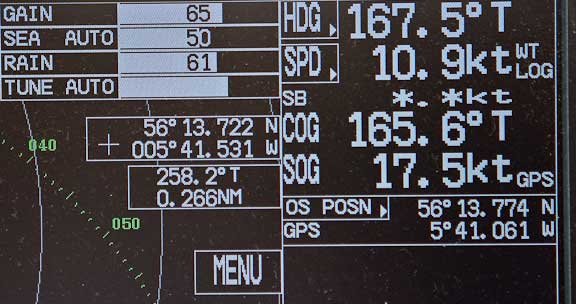
This being Scotland in summer, you expect the odd blow. But we are beset with foul weather. Southerly gale after gale, with lots of rain. However, we caught a break yesterday and awoke to momentarily blue skies and calm winds. We are on spring tides (when the moon and sun work together) so are seeing a bit of tidal current in spots. The photo above indicates SOG (speed over ground) of 17.5 knots. That’s 6.6 knots of positive current.
A few hours later, off the Mull of Kintyre, things were a bit more adverse.
Which alternator do you use?
Hello,
I am interested which alternators you are using on you boats. I have read about 2 pcs. Electrodyne 150A/24V. Gut on the website of Electrodyne they also say to have 250A/24V pieces. Would that be an option as well?
Are you not heating the batterie’s to much while loading the them that fast? How many Amp/hrs are they in your boat?
Thanks in advance,
Berend
Tobermory, Scotland
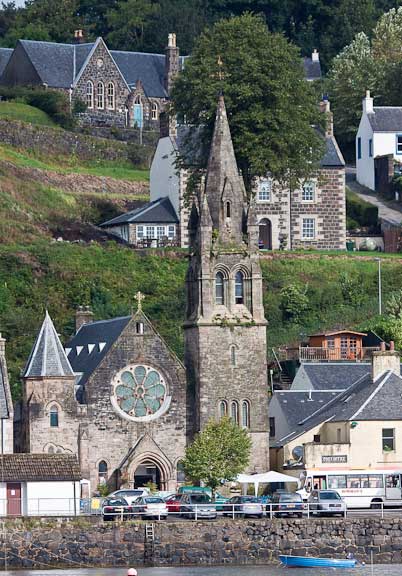
We’ve been hanging out in Tobermory, Scotland for the past week. If you have to sit in a town, this is a nice spot in which to do it. The anchorage is substantial, there is a marina, a mooring field, interesting shops ashore, and wifi at the dock. Tobermory is also an excellent base from which to explore the Isle of Mull.
Hurricane Bill – Extra tropical Transition
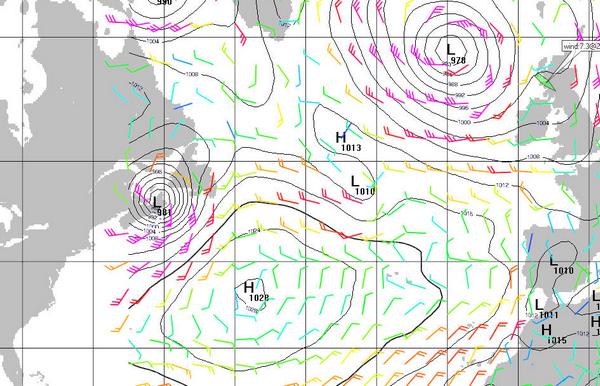
We are in the habit of watching the GFS weather model via Sailmail’s Saildocs offerings. This morning Hurricane Bill popped up. We’re not interested in the tropical phase but in seeing if it is forecast to transition to extra tropical structure.
The chart above is for 96 hours from now or 000Z on the 24th. Note that Nova Scotia and Newfoundland are in the path even though they are surrounded with cold water. No doubt those of you along the Eastern Seaboard of the U.S will be watching Bill closely.
The question we are concerned with here, about transition of the structure of the storm, will be based on what is going on at the 500mb and higher levels.
Now look at 120 hours from now.
Riding Sails For Power Boats
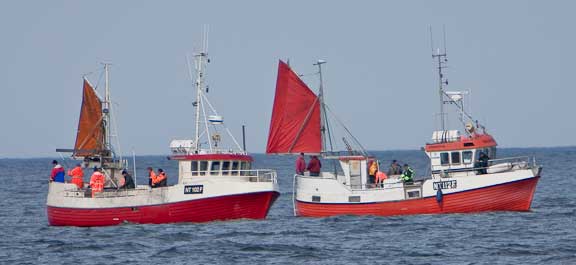
We’ve fitted riding sails on the backstays of many sailing designs (see our Offshore Cruising Encyclopedia for details), but have never thought of them in the context of a power boat. Until we came to Norway.
WASHING MACHINE
What do you think about having a washing machine on board a boat for a family of four about to go cruising for a couple of years (maybe more)? We could make the space for it.
Scotland Odds and Ends
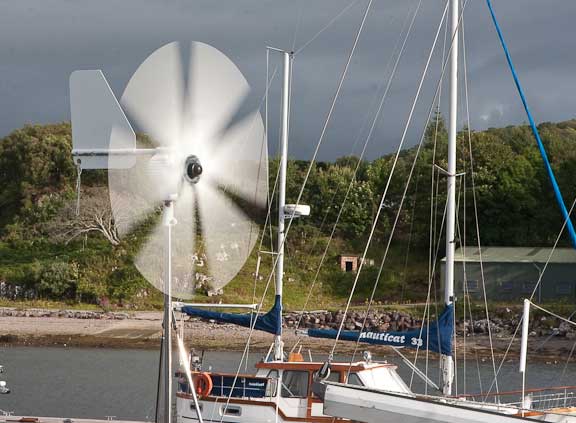
Sometimes things which make no sense become more clear with experience. Take the small diameter low output windmills so often fitted to British cruising yachts. The small diameter blades take a lot of breeze to get meaningful output. Cruising in the tropics there is rarely enough wind to make these useful. The same would apply to the East or West Coasts of the US. But in Scotland, these are perfect (in other words, this is a windy place!).
The same applies to the Nauticat in the background. We used to think these were really a silly idea.
Castle Tioram, Scotland
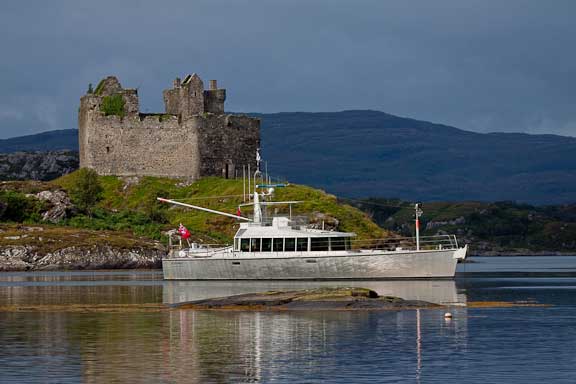
There are some photos you just have to have: anchored in Cooks Bay, Moorea, with coconut palms and those famous spires in the background; the boat framed by a hole in a giant iceberg, and a haunted castle for background in the British Isles. OK, we are now three for three and can retire (just kidding).
The Case For Two Dinghies
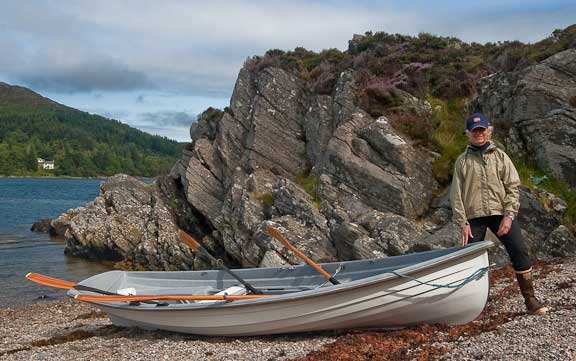
There is a strong case to be made for a second light weight rowing dink aboard. To begin with, it provides a backup if the outboard fails, or the inflatable is lost for some reason.
Swept-Back Spreaders
I just wondered what you think about the point the captain of the Morgan’s Cloud makes here about swept-back spreaders:
http://morganscloud.com/aacblog/2009/08/swept-back-spreaders-we-just-dont-get.html
Hull Plate Thickness
Steve,
I believe the hull plate thickness on the FPB65 is 12mm.
Can you tell me what you used for the FPB83 and Beowulf?
What was the deck plate thickness?
Thanks,
Henry
Loch Moidart – Sonar Navigation
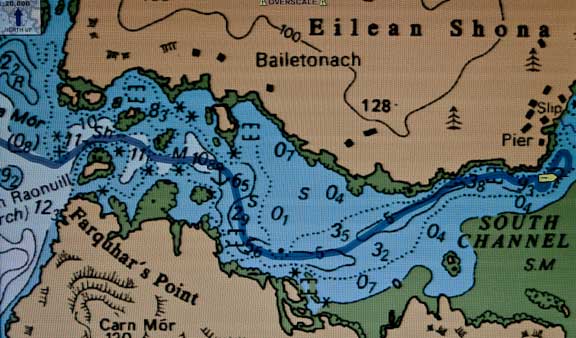
Loch Moidart is the type of cruising destination we look for. Beautiful surroundings, history, and navigational challenges to keep us sharp. As you can see from the chart above (the blue line represents our track) this is not an easy entrance. Depths are in meters (we draw 1.5m/five feet) and our entrance is an hour after high water, so we have almost four meters (13 feet) of positive tide. We are entering after high water for two reasons. First, this puts the current on our bow which makes steering easier. Second, if we go aground there will be a higher tide the next cycle to float us off. Winds are calm (we would not try this the first time in a breeze).
Fuel Costs September 2008
We have just topped off Wind Horse’s fuel tanks in Ireland, and have been recapping our consumption and costs for the 2008 cruising season. With all the headlines about US$150 per barrel crude, if you are like us, you would expect this to have been an expensive summer.
Fastnet 79 Storm – 30th Anniversary
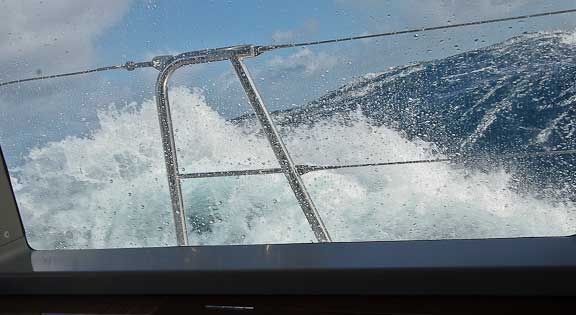
With the Fastnet Race (from Cowes, UK, around Fastnet rock off Ireland and back to Plymouth) starting this weekend we’ve been thinking about the 1979 Fastnet Race storm. This was a watershed event in terms of yacht design and heavy weather thinking.
We were well into our circumnavigation when we first heard rumors of this blow upon arrival in Durban, South Africa. Having gone through three days of gales south and west of Madagascar (in which several yachts were rolled but made it to port on their own) our first thought was the stories of abandoned yachts, sinkings, and death must have been exaggerated.
Shetland Island Yacht Details
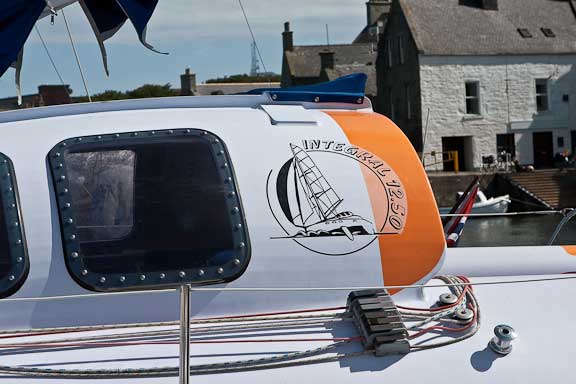
Destinations like Lewrick in the Shetland Islands are great places to look at yachts. You have boats from all over the world, and the location insures that they have to be sea worthy to get there.
This French Integral 12.5 stood out amongst the more conservative cruising designs. She is like a small Open 60. Excessively beamy, with a wedge shaped hull, twin rudders, tilting keel, and daggerboards.
Scotland
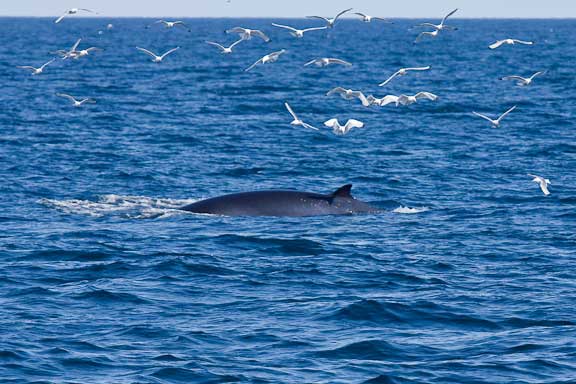
We’ve made the leap from the Orkneys to Scotland. The various guide books and Admiralty Pilots make interesting reading for this territory, but they are definitely not for the faint of heart. Between currents, shallow sea beds, reflected waves, and open ocean swells this is considered one of the most dangerous stretches of water on the planet. Cape Wrath is aptly named.
Although our brief (just a hundred miles, nine hours) passage is without incident, we can see how this might be challenging. With modest currents (we are just off neaps) and no more than 20 knots of breeze on the nose there are six foot plus (1.8m) close coupled seas.
UK Weather and Moving On To The Orkney Islands

There are usually seasonal patterns to weather, often associated with what is going on at the 500mb level. This is particularly true for areas like Cape Hatteras off the East Coast of the US, the Tasman Sea between Australia and New Zealand, and the Gulf of Alaska/Bering Sea region. It is also true for the eastern North Atlantic, the summer weather for which is usually dominated by the Azores High.
Except this year, as was the case last season, the Azores High is MIA. This has lead to lovely weather in Norway, but also to a succession of depressions forming around the British Isles. The fax segment above is typical of what we have been watching all summer.
New Wave Piercing Design

We are always in the lookout for new designs from the commercial end of seafaring. This oil rig standby vessel has a fascinating bow shape for working in the North Sea. Note how fine she is forward. There is none of the voluminous flare typically associated with commercial designs.
Danish Betty – Lerwick, Shetland Islands

We promised a few details on this lovely Danish schooner. As previously mentioned, she is a circa 1850s design fishing vessel, built in 1895 and lovingly restored by her present owner. She has moderate beam, balanced lines, and a powerful hull shape for carrying sail in the North Sea where it can be blustery (in the extreme).
Cockpit Protection
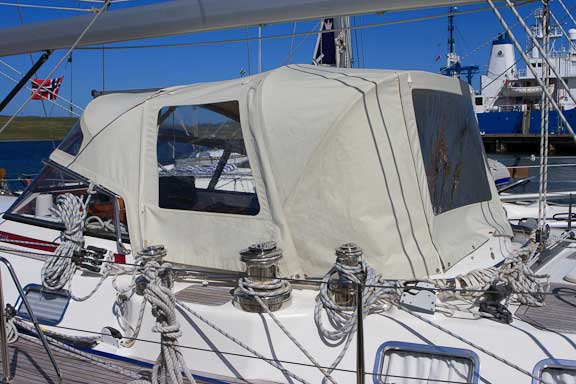
The longer you cruise, the more important crew protection becomes. This applies to cold and wet, and to sun.
Trade offs include:
- Access to running rigging and winches.
- Headroom inside.
- Sightlines from external helms over/through the cockpit cover.
- Heavy weather capability.
- Aesthetics (placed last for this discussion).
There are lots more details in our Offshore Cruising Encyclopedia. A few photos follow of different approaches observed in Lerwick, Shetland Islands.
New magazine article: Hidden Anchorages
 Linda has an article in the new issue of Berthon Lifestyles.
Linda has an article in the new issue of Berthon Lifestyles.
“…The kettle is on the stove for tea. The smell of freshly baked chocolate chip cookies wafts across the salon. And we sit, transfixed by the beauty which surrounds us…”
Hungry for more? Click here to download a PDF excerpt from the magazine.
Lerwick, Shetland Islands
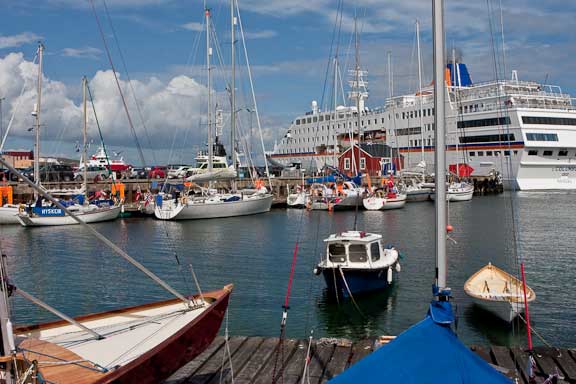
The sun is shining (doesn’t it always in the U.K?) and there is a large raft of cruisers (big and small) in Lerwick, the capital of the Shetland Islands. Dockage for yachts is at a premium and this time of year rafting is the norm.
FPB 64 Update #15
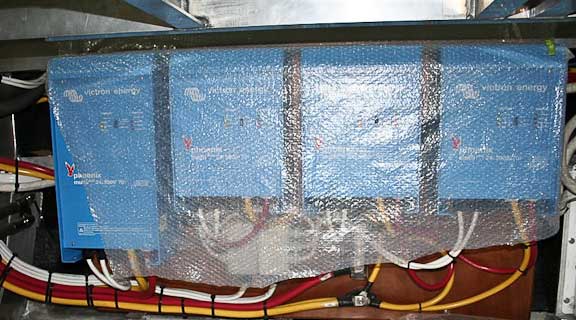
This update we have some catching up to do with photos.
The inverter system provides both 115VAC and 230VAC (on boats with just 230VAC the fourth inverter serves light loads like electronics and small galley appliances). Splitting the sources like this provides back up and reduces idling current when the stack of three inverters are not required for heavy loads.
Shetland Islands
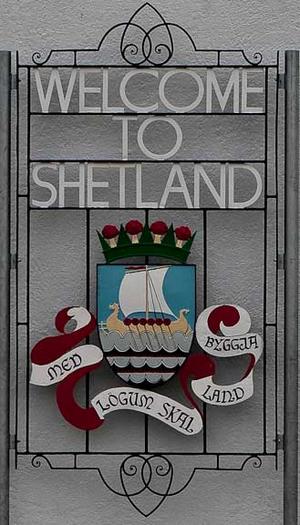
We’ve made the eighteen hour passage across the North Sea to the Shetland Islands (dodging oil rigs and survey vessels along the way), and are now enjoying Shetland hospitality.
John Deere power
I have a question regarding the John Deere propulsion engine: Does the engine have enough power for maneuvering the boat together with driving two alternators and a hydraulic pump? What is the capacity of the hydraulic pump connected to the PTO and is the bow thruster also fed by this pump? If yes, how strong is the bow thruster and can you use full bow thruster power on low engine RPM?
Thanks in advance for your answers.
Another question regarding the alternators: How long does it take to fully recharge 25% percent charged batteries (how much Ampere-hours is the battery bank totally?) with the two alternators? Regards, Berend Hartman
Camera Gear for Cruising

We’ve had a number of questions about the camera gear we use aboard Wind Horse. Shown above is what sees 98% of the action. We will describe the logic of these choices shortly, but first a comment on what you can get by with.
Longyearbyen, Svalbard
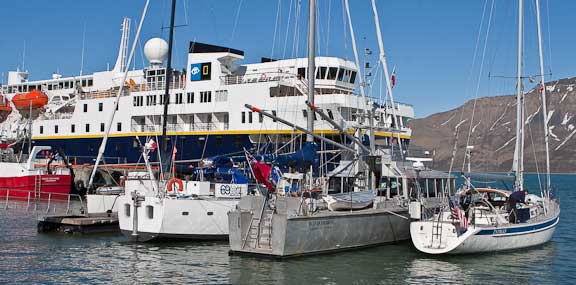
We forgot to post this when we were in Svalbard and are sending it along now.
Longyearbyen is the administrative center for the Svalbard Islands. A former mining town, it is remaking itself as a tourist center and doing well. The “marina” consists of two floating docks, to which yachts raft in various formations. We’re rafted between Southern Star (a 1970s era maxi) and the Halberg Rassey 46 Indigo .
FPB 64 Update #14
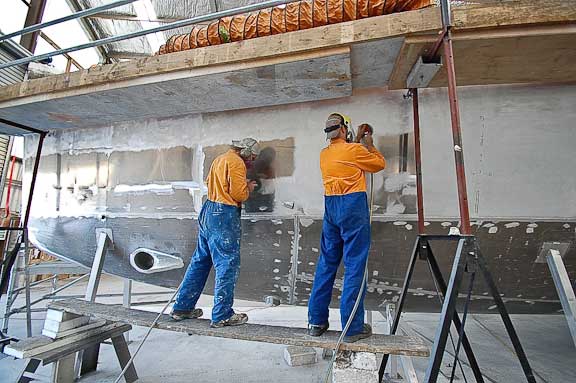
Things are moving swiftly in New Zealand on the FPB 64s. Hull number one is being ground now, and the plumbing and systems are just about ready for furniture installation to begin.
Heading South With The Sun
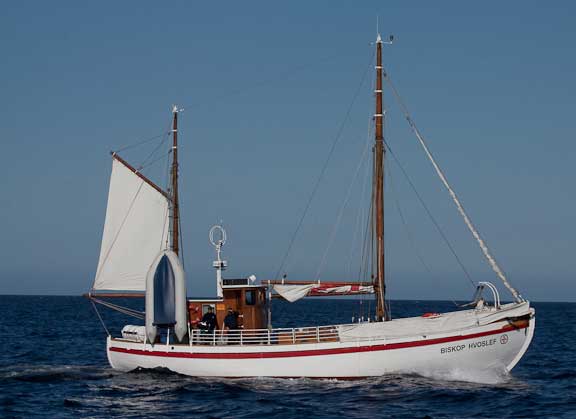
We’re pointed south towards the Shetland Islands and Scotland. The plan is to top off our fuel tanks in Maloy, Norway, and then make the short hop (185 miles) to the U.K.
We are ahead of the normal cruising schedule with a majority of yachts going in the opposite direction. This provides a wonderful opportunity for boat watching, one of our favorite things to do. The vessel above is a Colin Archer design, formerly part of the Norwegian Rescue Service fleet.
Svalbard Desert
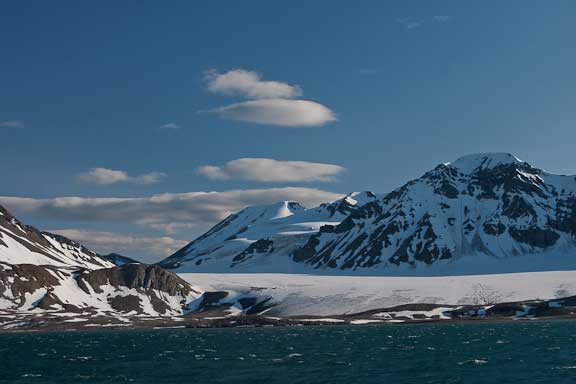
We thought we were done with the Svalbard Islands, but a combination of factors has delayed our departure.
Arctic Ice Pack at 80 North
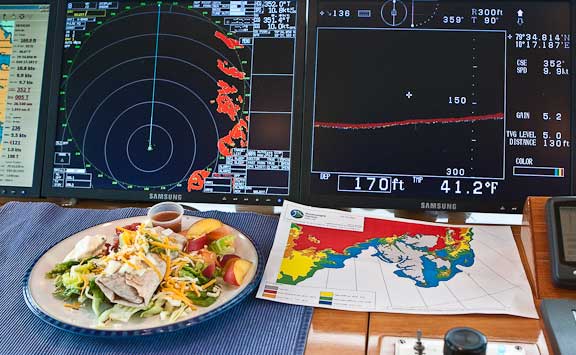
When we started thinking about heading north this summer one of the goals quickly became the Arctic ice pack and seeing if we could cross the magical 80 degree line of latitude. For most of the earth’s surface this is impossible due to ice. In many places you are doing well to even get to 70 degrees. But in Svalbard the end of the Gulf Stream keeps a sea lane open to the north in summer.
By 79.5 degrees we were starting to see small bits of ice and visibility was dropping due to intermittent fog. We slowed down, discussed turning around, and decided to wait and see if conditions would change for the better. In the meantime we had burritos for dinner. The ice chart from the previous day is bottom right in the photo. Svalbard is the gray area in the center of the chart. The colored areas represent various ice densities. Note how much further south the ice runs to the west (left).
Magdalena Fjord, Svalbard
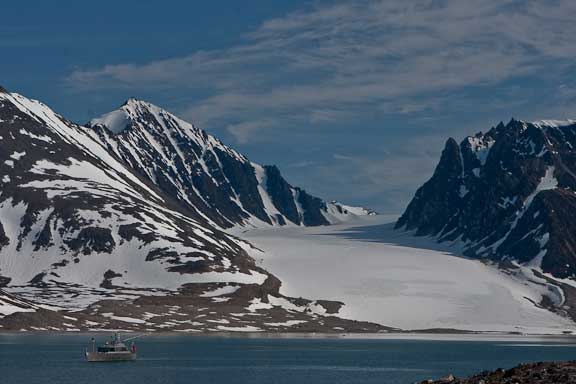
Magdalena Fjord is another magical anchorage. We are surrounded with glaciers, secure behind a sand spit from all but easterly (off the glacier) winds. Ice can be a problem, but we are fortunate in low densities right now. With perfect weather we decide to make this an official rest stop.
Polar Bear!
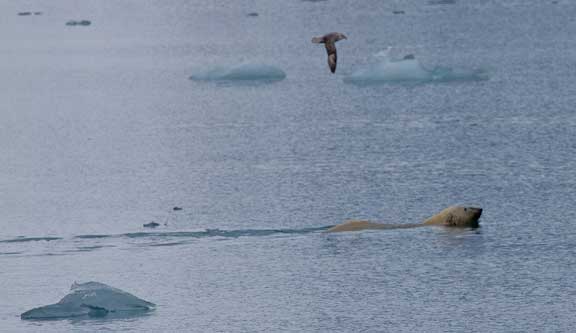
We were checking out Lillihoekbreen, a fjord just northwest of Ny Alesund, looking for a nice background to photography Wind Horse. Just as we were about to launch the dinghy Joe spotted something white with black nose in the water.
Ny Alesund, Svalbard
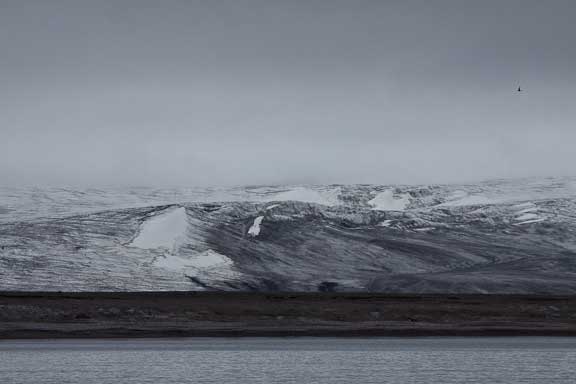
It is 0230 local time, and we are working our way into the fjord complex which is home to Ny Alesund. Low cloud and intermittent fog creates a forlorn look to the landscape.
Svalbard Walrus and Fog
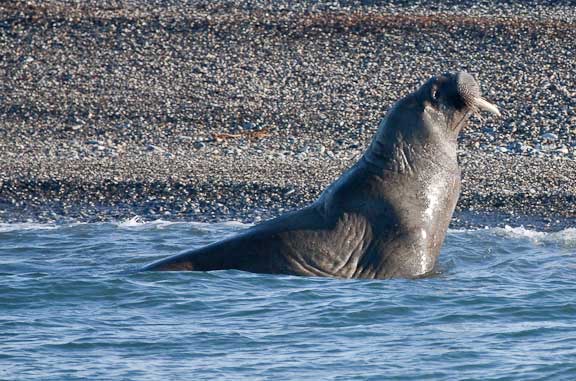
One of our objectives for Svalbard was to get within photographic distance of walrus. This fellow, and his mates, hang out at Princepynten Point in the Forland Sundet. The bottom shelves steeply, from 300 feet (90m) to 50 feet (15m) close to shore. Using our sonar we worked back and forth to get within camera range in light winds and a calm sea (we would not have done this in other than ideal conditions.
80 Degrees!
At 2129 GMT Wind Horse crossed the 80th parallel after threading our way through relatively open pack ice. Returning now to more temperate latitudes. Photos and details to follow when we have more time to write.
Ny Alesund – 79 Degrees North
We’re on the dock in Ny Alesund, at the mouth of Kongsfiord. At 79 degrees north this may be the closest town (150 or so inhabitants) to the North Pole. Formerly a mining town it is now a research center. Surrounded by immense glaciers, with parabolic antennae and abandoned mines, the scene is reminiscent of something out of Star Wars. We expect to find multi-headed characters when we visit the local bar.
Have had a busy few days trading inquisitive glances with walrus, fox, reindeer, and a variety of types of birds – but no polar bears yet.
Weather has been foggy and overcast (we backtracked 20 miles two days ago due to fog).
Yesterday the barometer started dropping and the wind switched to the south. We could not make this compute with the weather charts so decided to seek shelter until the barometer stabilized and we got a better handle on the risk factors.
Speaking of risk, we have to concentrate on not becoming complacent. Wind Horse is so comfortable, warm, and cozy, that it is easy to lose sight of where we are cruising. In this part of the world small problems can quickly become major, leading to unpleasant consequences. On the other hand, a bit of controlled risk adds spice to life.
We have lots of photos to share but not the band width to send them. Perhaps we will find an Internet Cafe ashore.
3000 Engine Hours -30,000+ Miles
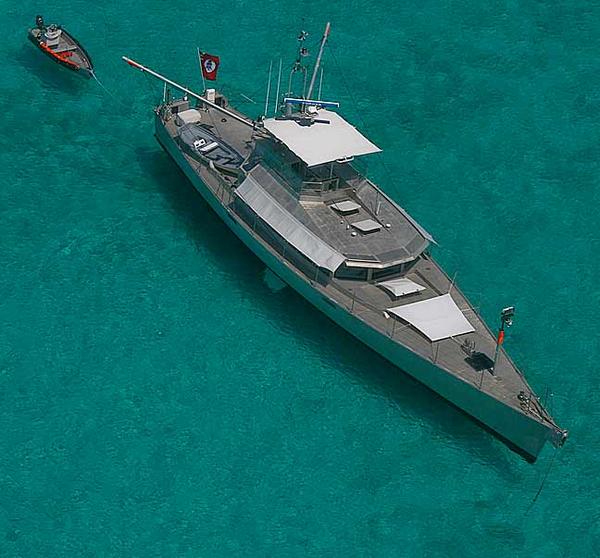
We’ve been doing our usual post passage inspection of the engine room, a part of which is writing up the engine log details with anything we find. This includes noting date and engine hours, which we are astonished to find now number 3010! That’s well over 30,000 nautical miles of cruising.
Wind Horse continues to surprise us with her ability to make voyaging comfortable. Add her cruising speed of 10.5 to 11 knots and you have a combination which invites usage – hence the mileage accumulated in 18 months of usage (which has taken place during the last three years). And we do not feel like we have been rushed. Rather, time feels like it is slowing down (we think this is due to fitting more experience into a given period).
Spitsbergen, Norway – 24 Hours of Adrenalin – Part One of Two
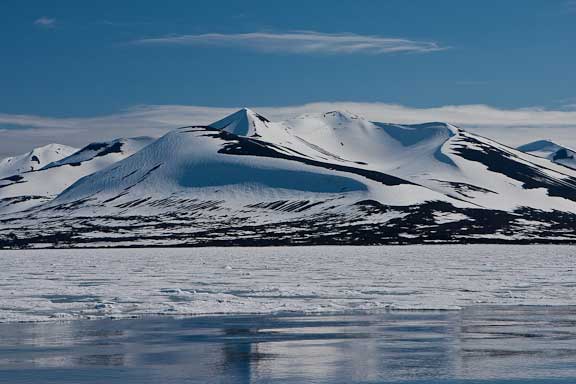
We are in Longyearbyen for 24 hours and able to upload photos. These will give you a feel for the visual impact of what we have been experiencing. All of these photos were taken within 24 hours between our visits to Hornsund and Bellesund.
Spitsbergen, Norway – 24 Hours of Adrenalin – Part Two of Two
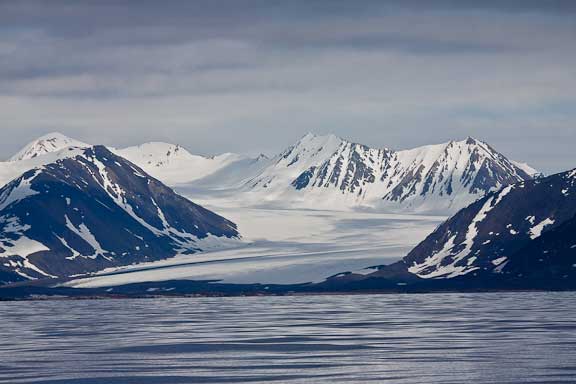
This 24 hour period started with blue sky and blinding sunlight. By early afternoon a mass of clouds had moved in. Five hours later and we had blue skies again.
Hornsund Under Blue Skies
We were chased out of our anchorage this morning by a medium sized berg bearing down on our position. It was time to explore Hornsund anyway.
We cannot begin to describe how lovely Hornsund and its many glaciers looks under an azure sky. Then, to make things interesting, a modulating layer of clouds moves in. Within an hour we have a new series of vistas to entertain us as the clouds, mountains, and glaciers interact.
The GFS model, just downloaded, indicates a continuing fair trend, so we are moving north. Now that 77 degrees is under the keel why not 78, or more?.
There’s a fog bank offshore, but with minimal ice in this area (so far) the fog is not a concern.
We’ve been told that our mobile broadband system may work near the town of Longbearyen, so we will try and upload some photos and show you what we have been experiencing in the next day or two.
Hornsund, Spitsbergen
The anchor is down in Isbjornhamna, Hornsund, Spitsbergen Island, Svalbard (how’s that for a mouthful)surrounded with glaciers.
The approach was uneventful, no ice, good visibility. It is 2130 and the sun is shining brilliantly under blue skies. Going to shower, have a short sleep, and start exploring.
7/3/2009 7:31 PM (UTC) position 76
Hard Beating In the Arctic
We’re 83 nautical miles from our way point outside of Hornesund. The light northeasterly breeze and calm seas have given way to a robust NW breeze of 20 knots. Waves are short and steep, albeit warm. Water temperature is an amazing 46.4F (8C).
In honor of being almost there a hearty breakfast has been consumed(spicy sausage, eggs with salsa, pineapple and kiwi fruit).
Last “night” – it is bright at 0130 – we saw a sail on the horizon and diverted course to check. Got some nice photos of a J-Boat beating with its high modulus main and jib. This is the first sailboat we’ve seen at sea since leaving California 15,000 miles ago. They looked beautiful, but cold.
We’ve been enjoying the abundance of bird life and the dolphin shows. The dolphins delight in doing aileron rolls. They must know there are two acro pilots in the audience.
7/3/2009 7:14 AM (UTC) position 75

